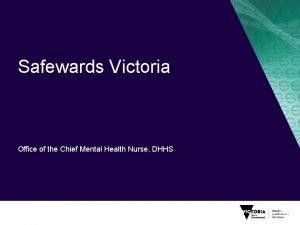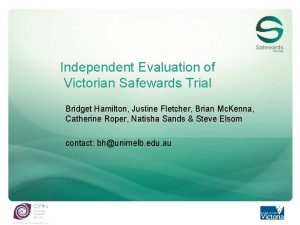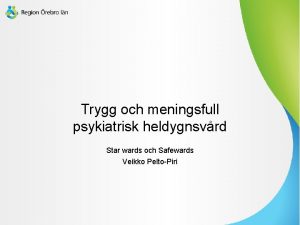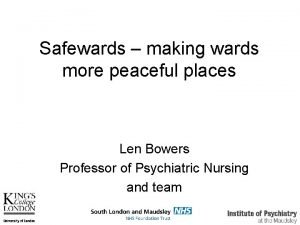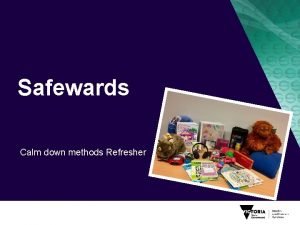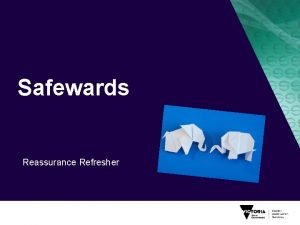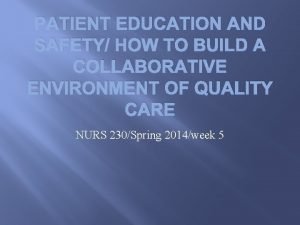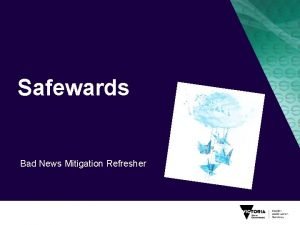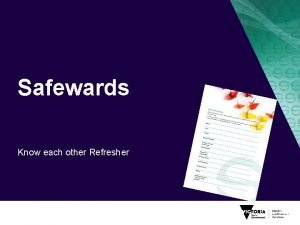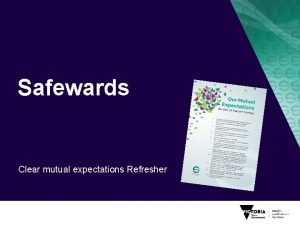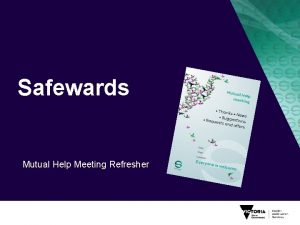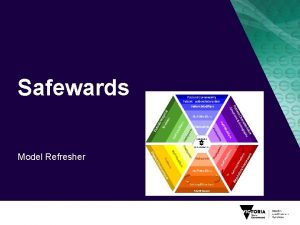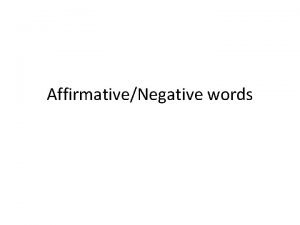Safewards Positive words Refresher Explanationinformation Role modelling Patient














- Slides: 14

Safewards Positive words Refresher

Explanation/information, Role modelling, Patient education, Removal of means, Presence & presence+ Staff Modifiers Denial of request, Staff demand, Limit setting, Bad news, Ignoring Flashpoints Staff anxiety & frustration, Moral commitments, Psychological understanding, Teamwork & consistency, Technical mastery, Positive appreciation Staff Modifiers A, , IC Rules, Routine, Efficiency, Clean/tidy, Ideology, Custom & practice Internal Structure Staff Team ics s s, ne c ti blo rs g rou tive ifie ckin erna od e, Che dy, Alt ff M isitiv & Ti Sta & inqu, Clean spect t oin de, shp litu Exit Fla ecy, Soshock, r Sec ission ked m Ad CONTAINMENT ork Anxiety management, Mutual support, Moral commitments, Psychological understanding, Technical mastery rist hy , Male, g cte p ed un ara ogra. , Abusall. s, Yo Ch em nhib s, H nt & d y/disi lusion tie Pa ptomsritabiliitght, De , Ir ns Symtraits sion, I s rs , PD re oia s, Dep an Par /drug Alc Patient Modifiers al f E r Ap ame xter pe wo n Re als, Prork, Natal Stru gul io s ato ecutionnal polcture ic s, ry Fra Hospitya, Comp la lp me w olicy ints, & sis ifie od erapy al analyns ff M coth ction entio Sta. Pharmya & fun& interv rap ort the upp cho g s ts Psy ursin N or al E sic t U Re ce ilan enan ices, PIC vig t n, cho gly Main sio nts rin Ca cor, es eclu poi Dé tur ity, S ture Fea plex , Liga om ooms , C t lity ory r en ua s , Q sen nm ked rt/ iro loc omfo nv C Do y Ph Leg Flashpoints Assembly/crowding/activity Queuing/waiting/noise Staff/pt turnover/change Bullying/stealing/ prop. damage oin s; y shp tion ntit Fla rba ide e c ce/ ty Exa nden everi s e ep ity/ Ind Acu CONFLICT C Fla Ad omp shp uls m o Co mp ission ory d ints l a tre int , App eten atm de ti e en nied al ref on, D t, E , En usa Ho ue p S t x pe l a it r f f , roc efu orce , Leg Infor ess, J f M sed d m o u Co itima atio stice dif nsi cy, n g , R ier ste e i nt Comp ving, spec s po licy ensa Supp t for , Fl tor ort righ exi y a bili uto to ap ts, p ty, n Re omy eal, spe , ct ie ctiv mil in e p y th volv rs ati era em en en t su py t pp F o l r Ba a t d n sh Los ew po s o s, H in acc f rela ome ts om tio cri Arg mod nship sis, um atio or en n, t Ou ito tsid De rs, Re pe e. H nd lative en osp cy s & f Str & i am ita e s nst i l itu ly ten sors tio na sions lisa tio , Pros n, De pecti ma ve Sta nd –ve Ca s& rer ff M /re ho move lat od me i F ve if a A Vis Patient Community Patient – patient interaction Contagion & discord

Background aims Background At handover the focus is often on describing challenging behaviour or risks to the patient or others. This may promote a negative perception of patients, rather than a balanced view of strengths and ways of working with a person. Aims • Know peoples’ strengths as well as their challenges • Give the staff something positive and practical to work with • Set an optimistic start to every shift • Try to redress the power differential (remember the person is not in the room!)

Positive words and the Safewards model Staff modifier: Using positive words & Staff modifiers psychological understanding in handover Patient modifiers Originating domains: Staff Team Originating Patient domains Characteristics Flashpoints Conflict Containment

Handover in practice Primary role • Only time the team gets together to discuss each patient • The meeting has a critical organisational function – discussion of key risks, new patient admissions Current approach Discussions are usually focused on: • Exceptional patient behaviour • Patient behaviour that is viewed as challenging or presents risks to others • Comments that can lead to a negative perception of patients and a negative start to the shift

Safewards approach to handover • Balance the natural tendency to focus on issues and negative aspects of patient behaviour • Positive words focus: 1. Say something positive about each patient at handover – Promote a positive appreciation of patients to reduce the likelihood of further conflict 2. When challenging behaviour or situations are described, offer a possible psychological explanation – Provide potentially useful strategies or information for working with the person Supporting document ‘Understanding patient characteristics and experiences’

Task: Using psychological explanations Break into small groups: 1. Understanding aggression and violence 2. Understanding self harm 3. Understanding seeking control and empowerment 4. Understanding absconding 5. Understanding medication refusal Activity: • Read the relevant section in the handout ‘Understanding patient characteristics and experiences’ • Discuss how the explanations in the handout could be applied in an actual handover

Task: Examples of negative words and phrases What are some of the negative words and phrases that are overused in your setting? What might be some alternatives you could use?

Using positive comments The handout provides possible psychological explanations. This slide provides possible positive descriptions of people. • Refer to past achievement, including before admission/illness • Engaging with an activity • Demonstration of coping • Making a contribution or demonstrating patience • Something the patient has enjoyed • • Enjoyed a walk or slept well Interacted more today Has smiled and made eye contact Returned to the unit on time after home leave • Looks brighter • Visits and phone calls that went well • Endurance and courage • Coping with things better • Expression of interest in something • Having a good conversation

Role of the intervention leads • In every handover, remind the person doing the handover to ask the following questions: – What is the positive message about this patient? – Why do we think the patient might have behaved in that way? • Give every staff member a copy of the document ‘Understanding patient characteristics and experiences’ • Use the document to interpret patient behaviour on the unit for others on the team, and share knowledge or strategies that may be helpful

Task: Why did you choose to work in mental health?

Video: The power of words https: //www. youtube. com/watch? v=Hzgzim 5 m 7 o. U

Positive words fidelity Positive words IS NOT • Tapping into the reason we came into mental health - that is, a desire to help • Helping staff recognise and share positive views of patients’ strengths and counterbalance negative perceptions • Helping staff use psychological explanations, knowledge and strategies that are helpful • Starting the shift with hope, optimism and respect = ≠ • A rhetorical illusion of looking good and seeming to care • Making sarcastic comments or describing patients in mock positive ways, concreting negative perceptions and culture

Positive words adjustments CAMHS None Forensic None Older people None, links to life story work
 Safewards positive words
Safewards positive words Talk down safewards
Talk down safewards Safewards nhs
Safewards nhs Safewards 10 interventions
Safewards 10 interventions Safewards talk down
Safewards talk down Discharge messages
Discharge messages Safewards 10 interventions
Safewards 10 interventions Safewards sverige
Safewards sverige Len bowers safewards
Len bowers safewards Safewards talk down
Safewards talk down Mutual help meeting
Mutual help meeting Talk down safewards
Talk down safewards Patient 2 patient
Patient 2 patient Patient admission process in hospital
Patient admission process in hospital Role of nurse in patient teaching ppt
Role of nurse in patient teaching ppt

